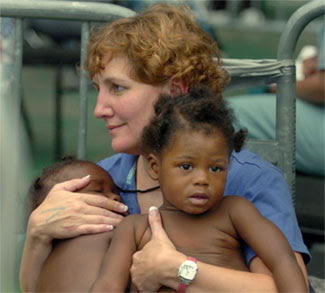"Man is the only animal that blushes. Or needs to."-Mark Twain (Following the Equator)

While studying the Great Depression over the last 16 months in anticipation of the collapse of our financial markets, I have, for the first time, been exposed to hundreds of photographs from the late-1920's and early-1930's.
In seeing just how abject basic life was for most people during the Great Depression, I got to thinking of how glad I am that America, as a country, has more weapons to ensure that the tide will not sink that low again. Government services are better run and more prepared for such things. People have more connectivity with one another, so if there is need in one part of the country, the word can get out to the proper authorities to assist in providing the goods and services needed to remedy the situation. And so on...
So we can all rest assured that even though it will be tough, there is no chance it will reach the depths of despondency visited upon the public in the early 20th Century, right?
This is more than likely the most famous picture of the Great Depression. A mother with her two children. She stares slightly away from the camera sending the conflicting messages of both strength/fortitude, as well as almost resigned helplessness. Her children look away from the camera while leaning on one of the two things they have learned to rely on in their young lives, their mother. The other being hunger.
Here a doctor attends to two children during Hurricane Katrina recovery efforts. The lady feigns a faint smile, but the children's comfort in her arms tell the true story. Naked, comfortable and asleep while in the arms of a perfect stranger. Only living through chaos of the highest order would allow children to settle in so comfortably in such circumstances. The adult must be considering the fate of the children, even as she ponders the next order of business in her effort to assist those in need.
So there we have it, the beginning of a quick reminder that anything is possible.
The following images will compare images culled from The Great Depression and juxtapose them with those of Hurricane Katrina. The similarities are eerie, but perhaps it can lead to a better handling of our civic situation, should things turn (and I pray they do not) for the worse for our country.
I will cease with the melodramatic commentary going forward, limiting myself to more simple observations.
Both situations produced unimaginable housing conditions:
We cannot allow this to happen a third time to our neighbors.
Families found they had to travel with all their worldly possessions in the search for a new start.

 The constant migration lead to children being exposed to conditions, which ultimately proved deleterious to their health and well-being.
The constant migration lead to children being exposed to conditions, which ultimately proved deleterious to their health and well-being.
 People stood in long lines, hoping for basic provisions for their families. Be it a bread line, or a line for potable water.
People stood in long lines, hoping for basic provisions for their families. Be it a bread line, or a line for potable water.The signs from the citizenry called out for basic human dignity, NOT hand-outs.
Each and every time I think about how much more equipped we are as a country to handle Depression-like circumstances, I think of the massive failure in the last massive crisis we had to deal with on American soil.
Signs were everywhere before the disaster, giving us ample time to avert disaster.
This Doppler image from Katrina:
This (and every other) HEADLINE from 1929 (gave a heads up 6 months before starvation became widespread).
 Are we ignoring our canary?
Are we ignoring our canary?
 Are we ignoring our canary?
Are we ignoring our canary?I, for one, hope not.













0 other views:
Post a Comment